mobile View, to the German Version tap the flag


- Saxony (Sachsen)
- former federal country of the German Empire
- 1949–1952 country of the GDR
- 1952–1990 dissolved
- since 1990 federal country of the FRG
• Flags
• historical Flags
• Meaning/Origin of the Flag
• Coat of Arms
• Meaning/Origin of the Coat of Arms
• Cockade
• Map
• Numbers and Facts
• History
• Origin of the Country's Name
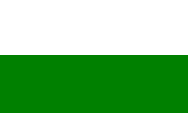
Flag of the country,
Source, by: Wikipedia (D)



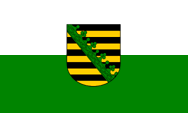
Official flag of the country,
Source, by: Wikipedia (D)





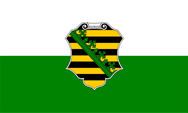
Flag of the Landtag (Parliament),
Source, by: Wikipedia (D)





to 1815,
Colors of the country,
Source, by: Wikipedia (D)




since 1815,
Colors of the country,
Source, by: Wikipedia (D)



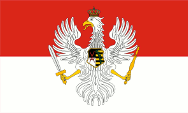
1697–1763,
Flag of the Kingdom of Poland under the rule of the house of Wettin




1815–1918,
Flag of the King,
Source, by:
Deutsche Wappen Rolle





The colors of the House Wettin are blue and yellow. They have their roots most likely in the crest of the Dominion of Landsberg. These colors were worn by members of the Swiss Guards at the electoral-saxon courts. The bands of some medals had been blue-yellow too. Black and yellow were for centuries the colours (livery color) of the Saxon courts (Albertine and Ernestine). They have their roots the regular coat of arms (black lion in golden field, which later became the arms of the Margraviate of Meissen) or in the coat of arms of the Duchy of Saxony. Black and yellow were used for certificate cords and for many military ensigns since the 17th century. However, national colors in the true sense, they were not yet.
The former Albertine electorate and new kingdom of Saxony joined the Rhine Confederation on 11th of December in 1806, on 15th of December in 1806 followed by the Ernestine duchies in Thuringia. The troops of the duchies were consolidated and equipped with cockades in black and gold in accordance with the convention of the 13th of February in 1807. The cockades of the Kingdom of Saxony remained white.
After the Battle of Leipzig Saxony became occupied (as a former ally of Napoleon), and it was formed the General Government of Saxony, which included Saxony-Altenburg and the Principalities of Reuss. As Governor General was installed the Russian Prince Nikolai Repnin-Volkonsky Grigojewitsch. Even in 1813 was proposed from the Saxon side (and approved by the Governor General), to create for Saxony a new gree-black-yellow cockade.
When the Saxon King Friedrich August I., of the dynasty of the Albertine Wettins, in May 1815 was returning home from captivity to Saxony after the end of the liberation wars against Napoleon, he instructed Lieutenant General of Lecoq at the 22nd of May in 1815, to reorganize and bring home, the at the River Rhine standing Saxon troops. The there until this point in time still white cockades on the caps of the soldiers were to surround with a green edge by this instruction of the king to avoid confusions with other troops. The news about the creation of the color combination of white and green spread very quickly, and arrived Saxony before the king. So he was received by his people with white and green garlands, flags and ribbons. In recognition of this fact, the monarch decided on 16th of June in 1815 to take over the white-green cockade for national cockade. That was the birth of the white and green as the colors of Saxony. The Saxon duchies (Thuringia), ruled by the Ernestine Wettins took mostly over these arrangements for their colors and flags.
The colours of the German states are (called Landesfarben, are often derived from the colours of the coats of arms, and used as cockades, as well as flags), were formed – especially in the German inland countries – rather late, often after the French Revolution and the following wars of liberation. In the period from ca. 1815 to ca. 1830, this process was finally completed in all German states.
In the following decades flags became increasingly fashionable, and it was often not sure whether white or green on the flag has to be on top. Finally, King Albert of Saxony had (king from 1873 to 1902) to investigate in archives, which showed that the sequence is white on the top and green below. This was published in May 1887 in various Saxon newspapers and thus brought to the general knowledge.
Another incident for the flag was the seizure of power by the National Socialists in the German Empire in 1933. All official non-swastika flags, that refered to federalism, regional references or the old German Empire were abolished between 1933 and 1935. For the National Socialists, the federal structure of the German Empire, its historically grown countries, was considered as outdated, as relics of a past to be overcome. In this sense, several laws were enacted, on 31st of March in 1933 the 'Provisional Law for the phasing of the countries with the Empire', on 7th of April 1933 the 'Second Law for the phasing of the countries with the Empire' and finally, on 30th January in 1934 the 'Law on the rebuilding of the empire'. Thus, the federal structure of the German Empire was replaced by the gau-structure of the NSDAP, the countries became meaningless. From now on, offices and authorities had to use the swastika flag as official flag, until September 15th in 1935, when by the flag-law was legislated a new created official flag for all the offices and authorities of the empire. The prime ministers of the countries, which latest in 1933 all came from the NSDAP – now mostly called Reichsstatthalter (maybe translated as 'governor') – however remained in office until 1945. The corresponding country colours continued, with restrictions, but definitly not in the form of flags. They were used, for example, occasionally on uniforms of the SA or in some ranks of the Hitler Youth in the breast cord.
After the war, the administration within the German Empire was rebuilt, but locally, following the structure of the countries. These have been partly old countries, and some new countries were created. Sometimes they bethought the old country colours and reactivated them – or they created new ones – for limited sovereign duties, which were under the control of the Allies. With the founding of the FRG and the GDR, an internal country-structure was finalised for both entities and corresponding official flags were introduced for these countries.
Source:
Jens Hild,
Volker Preuß,
www.sachsenlied.de,
Jürgen Kaltschmitt,
Uniform-Fibel

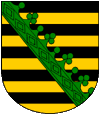
since 1918,
Coat of Arms of the free state,
Source, by: Wikipedia (D)
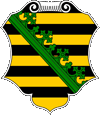
Coat of Arms of the Landtag (Parliament),
Source, by: Wikipedia (D)
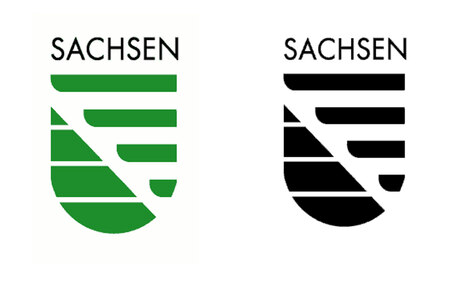
Saxony Sign, in modern (Symbol, Logo), colorful and b/w,
Source, by: www.freistaat.sachsen.de / Public domain, Wikipedia (D)
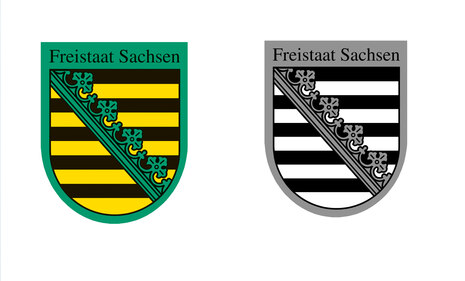
Saxony Sign, classical (Symbol, Logo), colorful and b/w,
Source, by: www.freistaat.sachsen.de / Public domain, Wikipedia (D)

1873–1918,
lesser coat of arms of the kingdom,
Source, by: Dr. Bernhard Peter
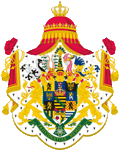
1889–1918,
dynastic coat of arms of the kingdom,
Source, by: Dr. Bernhard Peter
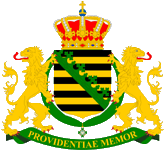
1854–1873,
middle coat of arms of the kingdom,
Source, by: Dr. Bernhard Peter
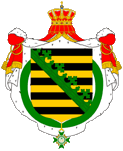
1827–1854,
Coat of arms of the kingdom,
Source, by: Dr. Bernhard Peter

1806–1827,
Coat of arms of the kingdom
Source, by: Dr. Bernhard Peter

since 1423,
Coat of arms of the electorate,
Source, by: Wikipedia (D)

The coat of arms of the Duchy of Saxony, which is until today the emblem of the Free State of Saxony, was created about 1180, as the Ascanians, Margraves of Brandenburg and Counts of Ballenstedt became to the Dukes of Saxony: over the coat of arms of Ballenstedt was placed a green diamond wreath. Black and Gold had been the colours of the empire.
With the acquisition of the dignity of the Arch Marshal the Saxon shield was combined from 1370 with the insignia of the Arch Marshal. It is now divided, shows not only the heraldry of the Saxon shield, further a field which is black and white horizontally divided, with two crossed red swords. With the downfall of the empire in 1806, and the elevation of Saxony to a Kingdom, this practice was no longer necessary.
In 1815 the King of Saxony decided, to surround the green cockades of the on the River Rhine standing troops with a white border (also see flags/cockades). This colour combination of white and green was officially established in the same year as the new national colors.
The use of the coat of arms is reserved for offices and authorities of the country. A country-sign is available for private use. It can be used by everyone, but its not allowed to change it.
Source: Volker Preuß,
Jens Hild,
Wikipedia (D),
www.freistaat.sachsen.de


17th/18th century,
Cockade of Saxony

1744–1813,
Cockade of Saxony

1813–1815,
Cockade of Saxony

1815-1867,
Cockade of Saxony

1867-1919,
Cockade of Saxony
Source: Jens Hild

Die Entstehung der sächsischen Kokarde
The cockade of the troops of the Kingdom of Saxony (and from 1807 of the Duchy of Warsaw too) has been single-colored white since 1744.

1744–1813, Sächsische Kokarde
After the Battle of Leipzig Saxony became occupied (as a former ally of Napoleon), and it was formed the General Government of Saxony, which included Saxony-Altenburg and the Principalities of Reuss. As Governor General was installed the Russian Prince Nikolai Repnin-Volkonsky Grigojewitsch. Even in 1813 was proposed from the Saxon side (and approved by the Governor General), to replace the existing white cockades by a new cockade. It showed the colors green, black and yellow, all colors taken from the Saxon coat of arms. Black and yellow are the national colors, and green is the color of the rhombus wreath. Black and yellow, not entirely coincidental, have been also the colors of the Russian coat of arms and of the cockade of the imperial-russian troops.

from 1813,
Saxon Kokarde

Russian Kokarde

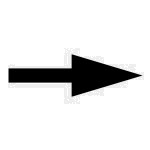



When the Saxon King Friedrich August I., of the dynasty of the Albertine Wettins, in May 1815 was returning home from captivity to Saxony after the end of the liberation wars against Napoleon, he instructed Lieutenant General of Lecoq at the 22nd of May in 1815, to reorganize and bring home, the at the River Rhine standing Saxon troops. The there until this point in time still white cockades on the caps of the soldiers were to surround with a green edge by this instruction of the king to avoid confusions with other troops. The news about the creation of the color combination of white and green spread very quickly, and arrived Saxony before the king. So he was received by his people with white and green garlands, flags and ribbons. In recognition of this fact, the monarch decided on 16th of June in 1815 to take over the white-green cockade for national cockade. That was the birth of the white and green as the colors of Saxony. The Saxon duchies (Thuringia), ruled by the Ernestine Wettins took mostly over these arrangements for their colors and flags. (more about the saxon cockade ← click here)
Read here:
Informations, history and facts about the theme "Cockades".

Cockade

FRG and its countries, clickable map:

Source: Freeware, University of Texas Libraries, modyfied by: Volker Preuß
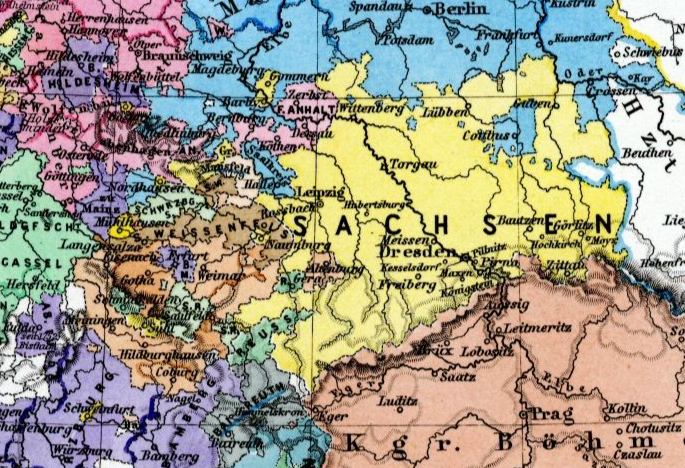
Source: Hand-Atlas für die Geschichte des Mittelalters und die neueren Zeit von Spruner und Menke
The historical map shows Saxony in the second half of the 18th century, coloured in yellow.

Area: 7.123 square miles
Inhabitants: 4.078.000 inh. (2018)
Density of Population: 572 inh./sq.mi.
Capital: Dresden, 554.500 inh. (2018)
Currency to 1872: 1 Taler = 30 Neugroschen = 300 Pfennig
Currency 1872–1924: 1 Mark = 100 Pfennig
Currency 1924–1948: 1 Reichsmark (RM) = 100 Reichspfennig (Rpf.)
Currency 1948–1952: 1 Mark der Deutschen Notenbank (MDN) = 100 Pfennig (Pf.)
Source: Wikipedia (D),
Der Michel

The history of Saxony begins with the ancient tribal Duchy of Saxony in today's northwestern Germany in the 5th century. In the Saxon Wars of Charlemagne (772–804), it was conquered and became annexed by the Franks, but it remained, however, as a duchy. Important dukes have been the dukes from the Welf Dynasty (Guelph), known for her opposition to the Hohenstaufen emperors, which ended in 1180 in the desintegration of the duchy by the emperor. The title of the Duke of Saxony remained, but was associated with peripheral regions of the ancient duchy and walked – with the investiture of various noble families – in principle the River Elbe up to the today's Saxony in central Germany. To distinguish it from the old Saxony, the ancient Duchy of Welf Dynasty (Guelph), the Wettin Saxony was called "Upper Saxony". This remained so until that point in time, when the name "Hanover" had prevailed for the old Saxony areas, latest by the elevation to the Kingdom of Hanover in 1814. Upper Saxony in 1806 also became a Kingdom, and the title of an elector was no longer necessary with the collapse of the empire in 1806. The Kingdom of Hanover existed until 1866, the Kingdom of Saxony until 1918.
965 · formation of the Margraviate of Meissen, as a fiefdom to the house of Wettin
1249 · elevation of the Margrave of Meissen (Heinrich the Illustrious) to the Landgrave of Thuringia
1382 · "Chemnitz Partition" in three parts of land (Osterland, Thuringia, Meissen)
1423 · the Meissen Margrave Friedrich 'the Martial' got Saxony-Wittenberg (Electorate of Saxony) as fiefdom, thereafter gradual pass of the name "Saxony" to the Margraviate of Meissen
1485 · "Leipzig Partition" of the Wettin's estates between the brethren Duke Albrecht (progenitor of the Wettin-Albertinians) and Elector Ernst (progenitor of the Wettin-Ernestinians); Duke Albrecht: County of Meissen, western Osterland, North Thuringia; Elector Ernst: Electorate of Saxony, South Thuringia, Vogtland
1547 · "Wittenberg Capitulation" the dignity of election passes from the Ernestinians to the Albertinians
1635 · "Prague peace" clector Johann Georg I. gets the Lausitz as fiefdom
1697 · elector Friedrich August I. (the Strong) becomes King of Poland
1756–1763 · "Seven Years War", the electors of Saxony lose the Polish throne
11th of December in 1806 · "Peace of Posen" Napoléon I. compels Saxony to the joining into the Rhine Confederation, elevation of the elector to a king
16th–18th of October in 1813 · Battle of Nations near Leipzig, Napoléon I. is conquered, Saxony segregates from Napoléon I., becomes occupied by military, and it was formed the General Government of Saxony under the Russian Prince Nikolai Repnin-Volkonsky Grigojewitsch (to 1815)
1814–1815 · Vienna Congress, punishment of Saxony because of his loyalty to Napoléon I., ceding of territories to Prussia: Lower Lausitz, Upper Lausitz, Kur-District and Thuringian territories
1848–1849 · civic revolution, riotings in Saxony
May 1849 · oppression of the May-Revolt in Dresden by Prussian squads
1866 · in the brother war on the hands of the German Confederation (Austria)
1866 · "Peace of Berlin", forced joining to the North German Confederation
1871 · joining to the German Empire
10th of November in 1918 · November's revolution in Dresden, overthrow of the monarchy
13th of November in 1918 · resignation of King Friedrich August III.
1st of November in 1920 · Free State of Saxony
1945 · invasion of Russian and US-American squads, as well as occupation of the Saxon territories eastern of the Neisse River by Poland, annexion of the leftovers of Silesia to Saxony
1949 · Saxony gets a country of the GDR
1952 · the countries of the GDR (and therewith Saxony) get dissolved
1990 · reconstruction of the Free State of Saxony, the Free State of Saxony gets a federal country of the FRG
Source: Atlas zur Geschichte,
Wikipedia (D),
World Statesmen,
Deutschlands Gebietsverluste,
Jürgen Kaltschmitt

The origin of the name "Saxony" lies in the 5th century in the old Duchy of the Saxons in what is now northwest Germany. The country was smashed by the German emperor in 1180, but the title of "Duke of Saxony" was retained. It was connected to the outskirts of the old duchy and, with the lending to various noble families, the name in principle migrated up the Elbe River to today's Saxony (the then Margraviate of Meissen under the house Wettin) in central Germany. To distinguish it from the real Saxon (the old Duchy), the Saxon of the house of Wettin was called "Upper Saxony". This remained until the term "Hanover" had prevailed for the old Saxon areas, which today are roughly summarized in "Lower Saxony".
Source: Volker Preuß








![]()















































